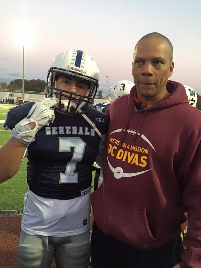 Get down to the basics players!
Get down to the basics players!
No time for pleasantries right now you are just a couple of months from training camp and the I know that at least 1/2 of you are not training right for various reasons. The #1 reason being that a good strength coach or personal trainer is not feasible or affordable. The time to train with your 'bud' here at US Sports is now! Click here and let's make sure you are ready to play at your highest level and most of all and parents please take note: STAY ON THE FIELD. Injury prevention is our first priority with all of our athletes and warriors. No more time to lose click here, fill out the fitness profile from and let's be ready by camp! Below is our boi' Robbie with some solid drills that you can master for maximum performance. Enjoy and get to work!
-Nate
Basic Football Drills For Running Backs, Tight Ends, And Wide Receiversby
Robbie FredricWith football season right around the corner, coaches are preparing drills and practice plays that will condition and train their football players to excel during game season. While playing each football position effectively helps win games, scoring touchdowns is primarily the job of the offense's three key positions: running back, tight end and wide receiver. Helping the quarterback advance the ball into the end zone is as demanding as it is meritorious. Here are some basic football drills players in these three key positions can practice to enhance their skills and remain healthy throughout the season.
Running Backs
-Ball Security Drill
Teaching running backs the proper way to secure the ball is the first step towards teaching ball security. Experienced coaches use the term "high and tight" to teach running backs to maintain three points of contact between a player's body and the ball: fingers, forearm and upper chest. Hold the football in the hand closest to the sideline; in case the ball becomes dislodged, it will bounce out-of- bounds. Running backs should use their free hand to block opponents and to maintain balance.
-Hand-off Exchange Drill
The ball must become an extension of the running back's body: inside arm up, outside arm down, create a pocket for the quarterback to "hand-off" the ball, tuck the ball, run up-field. Developing chemistry with the quarterback and practicing at game speed will augment this drill.
-Agility Drill
The ability to make cuts, juke, stop and go, and spin will cause defenders to miss tackles. Exercises, ladder drills, parachute and bungee resistance training, and cone drills reinforce agility.
Wide Receivers
-Catching Drills
Coaches should teach wide receivers to form a cone with their hands, thumbs and index fingers pointed toward each other, to catch the ball at the seams. This drill strengthens a wide receiver's finger-tips, enabling a receiver to catch and grip the ball, then securely bring the ball to the torso.
-Side to Side Drill
This football drill teaches body control and hand-eye coordination. This drill starts with two players facing each other on the goal line, standing five yards apart. On "go," both players start running sideways down the field, tossing the ball back and forth to each other until they reach the end zone. Both receivers repeat the same action running up the field back to the goal line.
-Sideline Tight-rope Drill
Improving a receiver's ability to catch the ball near the sidelines widens the field for the quarterback. Receivers should line up 10-15 yards from either sideline; on "go," a receiver will run full speed toward the sideline. The quarterback should throw the ball about 3-5 yards from the sideline. After catching the ball, the receiver should plant one or both feet in bounds before going out of bounds. If the receiver has to leave his feet to catch the ball, he should practice tapping his feet along the sideline marker before going out of bounds.
Tight Ends
-Carioca Drill
This agility drill will help tight ends improve their foot work, speed and agility. Some coaches may use a speed ladder to teach this concept or others may teach it the "old fashioned way." Place feet a few inches apart- right arm up in a relaxed position. Push off with the left foot, then cross it behind the right foot. Be sure to pull the knee up. With the right foot, quick step behind the left foot, then lift the knee up. Be sure your arms go up and down and to keep the knees up. Avoid looking down at the feet as when moving side to side.
-Weight Training
Weight drills build upper and lower body strength. Tight ends are bulkier in weight than wide receivers. Bench presses, power lifts, squats and standing upright rows with dumbbells build muscles in the three primary areas: upper body, core and legs.
-Blocking Drills.
A team mate or coach should hold a blocking pad up 2 or 3 yards away from the tight end. The tight end should get in stance, then explode into the pad pushing the holder backward. Tight ends should practice spinning off the block, then exploding upfield to position themselves to receive a pass.
-Catching Drills
Tight ends usually run short routes. The quarterback should throw short passes for the TE to practice running slant patterns, hooks, and ins and outs.
More Information:Get some free tips from an all-American, former pro soccer player that can help drastically improve your touch, shooting, and dribbling and give you masterful football skills - go to
http://www.bestsoccerdrills.bizSource:
http://www.PopularArticles.com/article463984.html



